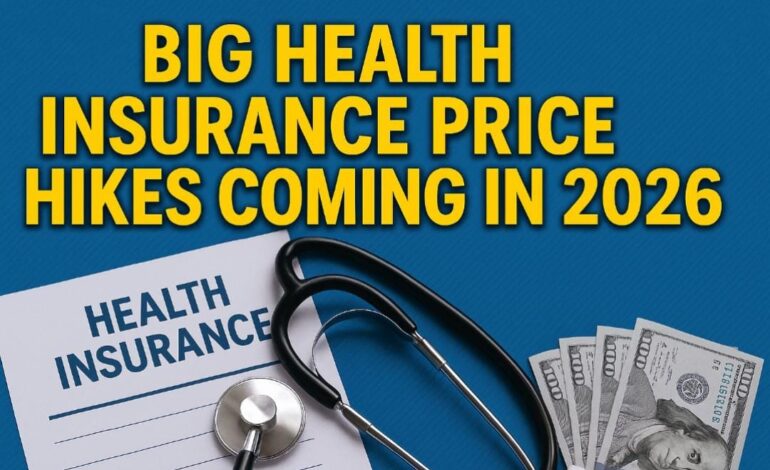
Big Health Insurance Price Hikes Coming in 2026: What You Need to Know
Health Insurance: Millions of Americans are likely to face steep health insurance costs in 2026—whether they buy plans through the Affordable Care Act (ACA) marketplace or get coverage from their employers.
According to a new Peterson-KFF Health System Tracker report published on July 18, insurers are planning median premium increases of 15% for ACA plans in 2026. This would mark the biggest price hike since 2018.
But the pain won’t stop there. More than half of large employers also plan to shift more health costs to employees and their families, according to a report from benefits consulting firm Mercer.
Why Are Premiums Rising So Fast?
Health insurers point to several key reasons behind these price increases:
- Rising medical costs are driving up spending across the board.
- Pandemic-era tax credits, which helped make ACA plans more affordable, are set to expire this year.
- New tariffs on prescription drugs and medical devices are raising insurer costs.
- Changes in federal law—including work requirements for Medicaid and rule changes affecting ACA sign-ups—are also adding uncertainty.
“These tax law changes have created a lot of uncertainty,” said Matt McGough, a policy analyst at KFF. “Insurers weren’t sure how to handle it.”
What Trump’s New Law Means for ACA Coverage
A major wildcard is how the new tax and spending law from President Donald Trump and Congressional Republicans will impact insurance pricing.
The law introduces work or volunteer requirements for Medicaid, which could cause millions of nondisabled adults to lose coverage. It also:
- Ends year-round ACA enrollment for people earning under 150% of the federal poverty line—a group that had seen major gains in coverage.
- Stops automatic renewals for ACA plans. Consumers will now need to update their income and details manually each year.
The Trump administration argues that Biden-era rules allowed too much fraud. A July 17 press release from the Centers for Medicare & Medicaid Services (CMS) revealed that 2.8 million Americans may have been enrolled in duplicate plans—either across multiple states or through both Medicaid and subsidized ACA coverage.
Health and Human Services Secretary Robert F. Kennedy Jr. said, “The Trump administration will no longer tolerate waste, fraud, and abuse at the expense of our most vulnerable citizens.”
End of Tax Credits Could Hit Low-Income Americans Hard
One of the biggest hits for ACA users will come from the end of enhanced tax credits, which were introduced under the Biden administration during the pandemic. These subsidies made ACA plans more affordable for millions and helped drive record enrollment.
Now, with those credits set to expire, the Congressional Budget Office estimates that about 5 million people could lose coverage.
KFF says ACA enrollees could see their out-of-pocket premium payments increase by over 75% on average. Many healthier individuals may choose to drop coverage, leaving insurers with higher-risk, sicker populations—further driving up costs.
Insurers Requesting Up to 28% Hikes in Some States
KFF reviewed rate filings from 105 ACA insurers across 19 states and Washington, D.C. Most are requesting premium hikes between 10% and 20%, but 28 insurers are asking for increases of 28% or more.
These proposed hikes will still need approval from state and federal insurance regulators later this fall.
Workplace Insurance Costs Are Going Up Too
It’s not just ACA users feeling the squeeze. Most working-age Americans get health coverage through their employer, and that’s getting more expensive too.
Mercer’s July 16 report found that:
- 51% of large employers are “likely” or “very likely” to shift more costs to workers by raising deductibles, copays, or out-of-pocket maximums.
- That’s up from 45% who said the same last year.
- Employer health costs are expected to rise 6% in 2025, and even more in 2026.
Earlier this decade, many companies avoided passing health costs onto workers due to tight labor markets. But with inflation cooling and medical costs rising fast, more companies are adjusting their strategies.
Beth Umland, Mercer’s director of health research, said that employers are also narrowing their provider networks—encouraging workers to use only those doctors and hospitals that offer discounted rates.
What It Means for You
Whether you’re on an ACA plan or covered by your employer, it’s clear that health insurance will cost more in 2026. Be prepared for:
- Higher premiums
- Bigger out-of-pocket expenses
- More paperwork or stricter enrollment requirements
- Smaller doctor networks and fewer plan choices
As changes continue to unfold, experts recommend comparing plans carefully during open enrollment, watching for state-level subsidies that may soften the blow, and checking if you’re still eligible for any remaining assistance programs.






